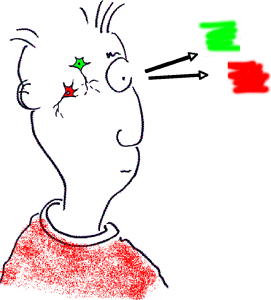Laura Spinney, a science journalist wrote several articles about Feel project. She has visited the five work packages of the project. Her first piece gives an interesting overview of the sensorimotor theory.
IT’S A DILEMMA beloved of barstool philosophers everywhere: imagine that, when you and I both look at a yellow flower such as a marigold, you see blue and I see yellow. If we both describe the marigold as yellow, and if we have both grown up making yellow-type associations whenever we saw marigolds, would there be any way of telling that our perceptual experiences of the flower’s colour were fundamentally different?
It’s called spectral inversion, and the British philosopher John Locke proposed it as a thought experiment in 1689. Latterday philosophers picked holes in his version and subtly reformulated the dilemma, but little work has been done to test whether it might be possible in the real world. Testing spectral inversion in the lab is one of the goals of FEEL, a new European Research Council-funded project led by Kevin O’Regan, former head of the Laboratory of the Psychology of Perception at Paris Descartes University in France.
FEEL is an attempt to tackle the hard problem of consciousness—what we mean when we talk about the sight of yellow, the sound of a bell, the taste of an onion or the softness of a sponge. What constitutes these “raw feels”, and how do we become conscious of them? For a long time—ironically, under the influence of the philosopher who lent his name to O’Regan’s university—the dominant idea among those who study the brain has been that sensation is generated inside that organ; that it is purely the product of activity in neural networks.
O’Regan’s research has led him to doubt that idea, and to ask the following question: how can activity in the brain give rise to the colour sensation we get when we look at a marigold, and how does one explain that this activity should give rise to the sensation of yellow, rather than the sensation of blue or of any other colour in the visible spectrum? How, in short, does the brain produce “feel”?
O’Regan believes the brain can’t do this, on its own, and that to locate the cause of feel in brain activity is a logical impossibility. That’s because, each time a scientist points to a neural mechanism that might encode a feel such as colour—a certain pattern of brain activity, say, or the activity of a neurotransmitter at a certain type of synapse—the question remains, why should that activity pattern or neurotransmitter correspond to one type of feel rather than another, to yellow rather than blue?
Scientists have been lured into that logical impasse by language, O’Regan says, and he gives the analogy of life. For centuries, our best thinkers believed life to be a substance—some kind of magical essence that animate objects had and inanimate objects didn’t. Then they shifted their frame of thought, realising that life could be better defined as the way that an object—a living organism, in this case—interacted with its environment.
Likewise, O’Regan suggests, feel does not lie in the brain, nor is it something that can be generated by the brain. It lies in the interaction of the brain with its environment. That interaction is in turn governed by what he calls sensorimotor laws. For example, the feeling of redness is in the set of ways that light hitting a red surface is transformed into light reflected from that surface and entering the eye, under a range of different lighting conditions. We sense redness when we know that, if we were to move our eyes or the surface we are looking at, the stimulation by light of the photoreceptors on our retina would change in a way that corresponds in a predictable fashion to our past experience of redness under similar conditions.
Importantly, according to the sensorimotor theory of feel, as O’Regan calls his approach to consciousness, the brain still plays a role and a critical one at that. Its role isn’t to generate feel, however, but to learn the relationship between eye movements and the resulting light changes—in the case of colour—and to become attuned to the mathematical relationship, or law, that defines that relationship for the colour in question.
The five work packages of FEEL will, over the next four years, explore different aspects of this theory as it relates to our conscious, sensory experience of the world, and we’ll describe those work packages in more detail in future posts.
Returning for now to the example of colour, imagine that you could devise some experimental trick to modify the sensory input a person’s brain receives when they look at an object of a certain colour. If you had two individuals sitting side-by-side in a lab, looking at the same marigold—one of whom had been subjected to the trick while the other hadn’t—the sensorimotor theory would predict that initially, they would have radically different colour experiences.
But then what? Over time, the theory predicts, the brain of the one who had been subjected to the trick would adapt to the new relationship that had been imposed on it. It would register that the laws that govern the light changes detected by the retina when the eyes explore the flower are the same as before, even though the resulting neural activation is different. That person would go back to seeing the flower as yellow.
This is the scenario the FEEL team would like to create in the lab, because they have many unanswered questions about it. Would colour experience return fully to normal, for example, or only partially? Would something similar happen in other senses? Would such an experiment also elucidate how newborn babies come to perceive the world, including their own bodies? To find out the answers to these and other questions, watch this space—and prepare for a rollercoaster ride into the hard problem of consciousness.

